Uniform Common Randomness Generation Over Arbitrary Point-to-Point Channels
IF 2.2
3区 计算机科学
Q3 COMPUTER SCIENCE, INFORMATION SYSTEMS
引用次数: 0
Abstract
We consider a standard two-source model for uniform common randomness (UCR) generation, in which two terminals (Terminal在任意点对点通道上产生统一的公共随机性
我们考虑了统一共同随机性(UCR)生成的标准双源模型,其中两个终端(终端a和终端B)观察相关有限源的独立和同分布(i.i.d)样本,并且允许终端a通过任意单用户通道向终端B发送信息。我们提供了一个一般的理论框架,从这个框架中作为特例给出了UCR容量的一般公式的证明和特定模型的$\epsilon $ -UCR容量的一般界。加州能力被定义为最大可实现的CR率两个终端可以达成一个共同的统一或近均匀随机变量概率任意接近1,而\ε加州能力被定义为美元的最大CR率可以达到这样的概率两个终端不同意共同制服或几乎均匀随机变量不超过\ε,美元在0 \ lt \ε\ lt 1美元是固定的。建立的UCR容量的一般公式依赖于表征任意点对点信道传输容量的公式,如Verdú和Han所阐述的。推导出的$\epsilon $ -UCR容量的一般下界和上界取决于$\epsilon $ -传输容量的相应下界和上界,如Verdú和Han对任意点对点信道所证明的那样。由于我们考虑的是一般的通道,除了可能出现不连续问题的至多可数的点外,推导出的边界是相等的。在此基础上,我们进一步给出了两个通道的建立边界相等的例子,并研究了其导出的下界的左连续性和单调性。
本文章由计算机程序翻译,如有差异,请以英文原文为准。
求助全文
约1分钟内获得全文
求助全文
来源期刊

IEEE Transactions on Information Theory
工程技术-工程:电子与电气
CiteScore
5.70
自引率
20.00%
发文量
514
审稿时长
12 months
期刊介绍:
The IEEE Transactions on Information Theory is a journal that publishes theoretical and experimental papers concerned with the transmission, processing, and utilization of information. The boundaries of acceptable subject matter are intentionally not sharply delimited. Rather, it is hoped that as the focus of research activity changes, a flexible policy will permit this Transactions to follow suit. Current appropriate topics are best reflected by recent Tables of Contents; they are summarized in the titles of editorial areas that appear on the inside front cover.
 求助内容:
求助内容: 应助结果提醒方式:
应助结果提醒方式:


